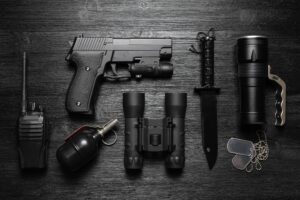
Individuals can face upgraded criminal charges when they are found to have used or to be in possession of a deadly weapon during the commission of a crime. While a firearm is an obvious example of a dangerous weapon, many other tools and devices may be considered a dangerous weapon in the eyes of the law based on the facts of your case. In today’s blog, we take a closer look at how the law defines a dangerous weapon in Minnesota when it is used in the commission of a crime.
Examples Of Dangerous Weapons
There is no set list that lays out every possible item that can be considered a dangerous weapon in the eyes of the law. While there are some items that are clearly considered a deadly or dangerous weapon, like guns or knives, the court will typically look at some specific factors when determining if a dangerous weapon was used during the commission of the alleged crime. Those factors include:
Design – Is the item designed in such a manner to have the potential to cause great bodily harm, like a firearm, knife or hatchet?
Actual Use – Some items may not be considered a dangerous weapon until we apply their use to the specific situation. A hammer or scissors may not be considered a deadly weapon at a construction site or a hair salon, but breaking into a home with these items on your person may be considered a deadly weapon since you aren’t planning on hammering a nail or giving a haircut.
Perception – How was the use of the item perceived by the victim or victims? Did your possession of that item strike fear into the victim? Even if you personally never intended to use the item, if your possession of the weapon caused the victims to act or feel a certain way, it may be considered a deadly weapon by the court. For example, if you commit a crime with an unloaded gun, you may argue that nobody’s life was ever in danger during the crime because the weapon was unloaded. However, the victim would not know that the gun was unloaded, and they may act as if their life is at risk, meaning this would be considered a dangerous weapon for the sake of criminal charges.
Some items that may be considered a deadly weapon based on the facts of the case include:
- Firearm (loaded or unloaded)
- Knife
- Hammer
- Scissors
- Crowbar
- Incendiary devices
- Brass knuckles
- Swords
- Batons
- Vehicles
This is far from a comprehensive list, because so many different objects can turn into a dangerous weapon based on how they were used during the crime. A beer bottle wouldn’t be considered a deadly weapon when you’re bellied up to the bar, but if a fight occurs out and you break the bottle to create a sharp and jagged tool, it could be considered a deadly weapon if you attack someone with it.
Committing a crime with a deadly weapon can lead to enhanced charges and potential penalties. Minor misdemeanors can be upgraded to felonies in no time, which can carry much heftier fines and mandatory jail time. We can help make a case to the judge that your use or possession of an item should not be upgraded to a deadly weapon classification, but it’s best to avoid putting yourself in this position in the first place.
If you’ve been charged with assault with a deadly weapon or another crime that has been upgraded due to the presence of a deadly weapon, let a lawyer go to work for you. Avery and his team have extensive experience helping clients out of similar situations, and he can do the same for you. For more information, or for help with a different criminal matter, give Avery and the team at Appelman Law Firm a call today at (952) 224-2277.





